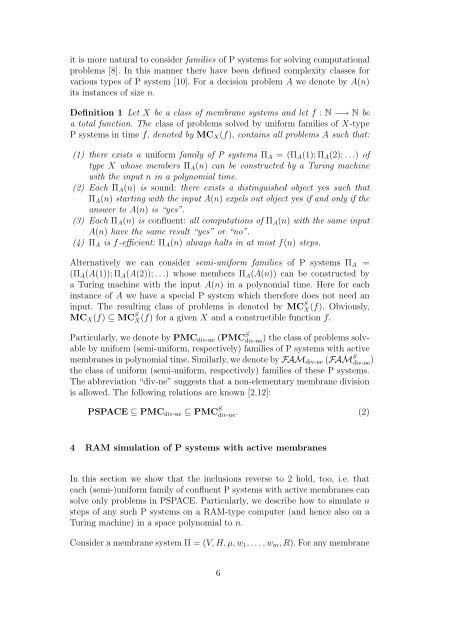P Systems with Active Membranes Characterize PSPACE
P Systems with Active Membranes Characterize PSPACE
P Systems with Active Membranes Characterize PSPACE
Create successful ePaper yourself
Turn your PDF publications into a flip-book with our unique Google optimized e-Paper software.
it is more natural to consider families of P systems for solving computationalproblems [8]. In this manner there have been defined complexity classes forvarious types of P system [10]. For a decision problem A we denote by A(n)its instances of size n.Definition 1 Let X be a class of membrane systems and let f : N −→ N bea total function. The class of problems solved by uniform families of X-typeP systems in time f, denoted by MC X (f), contains all problems A such that:(1) there exists a uniform family of P systems Π A = (Π A (1); Π A (2); . . .) oftype X whose members Π A (n) can be constructed by a Turing machine<strong>with</strong> the input n in a polynomial time.(2) Each Π A (n) is sound: there exists a distinguished object yes such thatΠ A (n) starting <strong>with</strong> the input A(n) expels out object yes if and only if theanswer to A(n) is “yes”.(3) Each Π A (n) is confluent: all computations of Π A (n) <strong>with</strong> the same inputA(n) have the same result “yes” or “no”.(4) Π A is f-efficient: Π A (n) always halts in at most f(n) steps.Alternatively we can consider semi-uniform families of P systems Π A =(Π A (A(1)); Π A (A(2)); . . .) whose members Π A (A(n)) can be constructed bya Turing machine <strong>with</strong> the input A(n) in a polynomial time. Here for eachinstance of A we have a special P system which therefore does not need aninput. The resulting class of problems is denoted by MC S X(f). Obviously,MC X (f) ⊆ MC S X(f) for a given X and a constructible function f.Particularly, we denote by PMC div-ne (PMC S div-ne) the class of problems solvableby uniform (semi-uniform, respectively) families of P systems <strong>with</strong> activemembranes in polynomial time. Similarly, we denote by FAM div-ne (FAM S div-ne)the class of uniform (semi-uniform, respectively) families of these P systems.The abbreviation “div-ne” suggests that a non-elementary membrane divisionis allowed. The following relations are known [2,12]:<strong>PSPACE</strong> ⊆ PMC div-ne ⊆ PMC S div-ne. (2)4 RAM simulation of P systems <strong>with</strong> active membranesIn this section we show that the inclusions reverse to 2 hold, too, i.e. thateach (semi-)uniform family of confluent P systems <strong>with</strong> active membranes cansolve only problems in <strong>PSPACE</strong>. Particularly, we describe how to simulate nsteps of any such P systems on a RAM-type computer (and hence also on aTuring machine) in a space polynomial to n.Consider a membrane system Π = (V, H, µ, w 1 , . . . , w m , R). For any membrane6
















